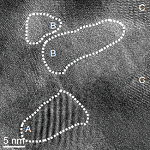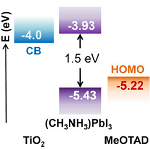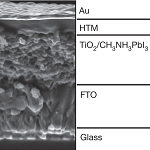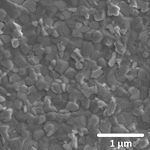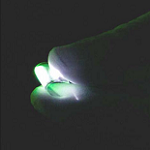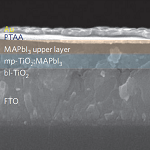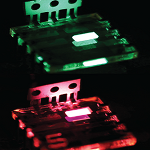Milestones
1994
Conducting tin halides with a layered organic-based perovskite structure
David Mitzi et al., Nature 369, 467-469 (1994), doi:10.1038/369467a0
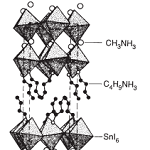 In the search for high-Tc superconductors, layered copper oxide perovskites were at the forefront in the 80s and 90s. Motivated by the search for ever-higher transition temperatures, David Mitzi and colleagues reported a conducting layered tin iodide with a perovskite structure, crucially with alkylammonium cations providing organic modulating layers in between the tin iodide sheets. Though the material broke no records for superconductivity, the intriguing electronic properties and ability to tune these hybrid perovskite structures paved the way for their use in photovoltaics and optoelectronics.
In the search for high-Tc superconductors, layered copper oxide perovskites were at the forefront in the 80s and 90s. Motivated by the search for ever-higher transition temperatures, David Mitzi and colleagues reported a conducting layered tin iodide with a perovskite structure, crucially with alkylammonium cations providing organic modulating layers in between the tin iodide sheets. Though the material broke no records for superconductivity, the intriguing electronic properties and ability to tune these hybrid perovskite structures paved the way for their use in photovoltaics and optoelectronics.
2012
All-solid-state dye-sensitized solar cells with high efficiency
In Chung et al., Nature 485, 486-489 (2012), doi:10.1038/nature11067
Shareable link
A solution-processable inorganic semiconductor is reported that can replace the liquid electrolyte of dye-sensitized solar cells, yielding all-solid-state solar cells with impressive energy conversion efficiencies.
Lead Iodide Perovskite Sensitized All-Solid-State Submicron Thin Film Mesoscopic Solar Cell with Efficiency Exceeding 9%
Hui-Seon Kim et al., Sci. Rep. 2, 591 (2012), doi:10.1038/srep00591
Methylammonium lead iodide perovskite was initially used in photovoltaic applications in the form of light-absorbing nanocrystals sensitizing liquid-junction mesoscopic solar cells. Here this material also shows efficient charge transfer to TiO2 and spiro-MeOTAD charge transporting layers, enabling the realization of all-solid-state photovoltaic devices.
2013
Sequential deposition as a route to high-performance perovskite-sensitized solar cells
Julian Burschka et al., Nature, 499, 316-319 (2013), doi:10.1038/nature12340
Shareable Link
A method of producing perovskite-sensitized solar cells by sequential — as opposed to single-step — deposition of the perovskite’s components onto a nanoporous titanium oxide film allows for greater reproducibility of device performance and a record power conversion efficiency of 15 per cent.
Efficient planar heterojunction perovskite solar cells by vapour deposition
Mingzhen Liu et al., Nature, 501, 395-398 (2013), doi:10.1038/nature12509
Shareable Link
The use of organometal halide perovskites as the light-absorbing material in nanostructured solar cells has increased efficiency to practical levels; here it is shown that vapour deposition of the perovskite removes the need for complex nanostructures and will hence simplify large-scale manufacture.
2014
Low-temperature solution-processed wavelength-tunable perovskites for lasing
Guichuan Xing et al., Nat. Mater. 13, 476-480 (2014) doi:10.1038/nmat3911
Shareable Link
Solution-processed hybrid halide perovskites are shown to be promising for lasing applications, because of the high optical gain and stable amplified spontaneous emission they show in the visible spectral range.
Solvent engineering for high-performance inorganic-organic hybrid perovskite solar cells
Nam Joong Jeon et al., Nat. Mater, 13, 897-903 (2014), doi:10.1038/nmat4014
Shareable Link
Solvent-engineering enables the deposition of very dense perovskite layers on mesoporous titania, leading to photovoltaic devices with high light-conversion efficiency and no hysteresis.
Bright light-emitting diodes based on organometal halide perovskite
Zhi-Kuang Tan et al., Nat. Nanotechnol. 9, 687-692 (2014), doi:10.1038/nnano.2014.149
Shareable Link
Electroluminescence with relatively high radiance is observed from solution-processed diodes of organometal halide perovskites.


